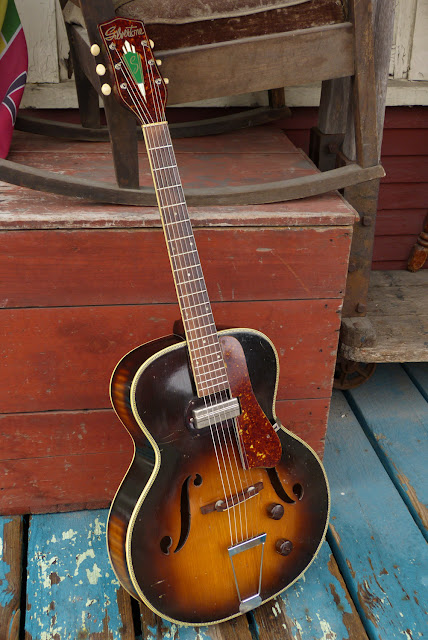1949 Harmony-made Silvertone Hollowbody Electric Guitar
This bears the Silvertone brand (Sears catalog), but any electric hollowbody nut will tell you that this is a rebadged Harmony H50 -- though inside the f-hole the Harmony model number is H53. I worked on an H50 a while back and I thought it was superb. The guitar is essentially a Harmony-made, poor man's ES-125 with a full-depth, 16" lower bout body and single neck pickup. The stock neck pickup on these is actually recycled Gibson-fare, too -- in this case the simpler lap steel version of a Gibson P13 pickup. Check out a '41 ES-150 to hear the "polepiece" P-13 in action.
The body on this guitar is entirely ply (unusual for Harmony) save the sides (which are solid birch) and it definitely had some condition issues when it came in. I've buttoned it up and you can see the details of the work in full at this "workshop" blog post, but suffice to say it got a neck reset, fret level/dress, a pickup swap-out (though the new P90 is hidden under the old cover), a "soundpost" install, and bridge modification. The soundpost shored-up the top because Harmony didn't bother to brace the guitar at all... hence the "press-arched" top wanting to go flat over time.
The result, after all the work, is a very practical, great-sounding, perfect-playing (3/32" EA, 1/16" DGBE at the 12th fret), full-on jazz/blues-box that will dirty-up as you like or clean-up as you like. It's strung with 50w-11 strings and I can see it as an excellent chord-banger in session with other folks... or with a bit of drive as a nice, bluesy, lead machine.
The sunburst and fancy purfling and binding give the guitar a deluxe look. Aside from the pickup, the whole thing is original, too.
The fancy headstock veneer is typical of nicer Silvertone-branded guitars from this time. This has its original bone nut, too, and the neck has a medium C-shape to it (pretty comfy, actually) with a light, 14" radius to the board.
The board is rosewood and has faux-pearl dots. Note the tooling marks from Harmony's cutting machine. Every radiused Harmony board shows these and they get worse and worse as the company gets closer to the 1970s.
To get the pickup closer to the strings, I moved its mounting tabs to the top of the pickup ring, instead, after shooting the original photos.
The 4-ply pickguard is handsome, no?
Because of a sunken top, I refit the bridge with taller adjustment posts and thicker feet to jack it up.
Who doesn't love the old bakelite "radio knobs" Harmony used?
The back and sides are finished in a "faux flame" look. That's painted, rather than actual flamed maple.
While the back shows some funk in the old seam repairs, it's good to go. A replacement StewMac strap button is at the endpin hole.






















Comments